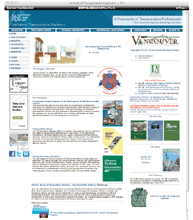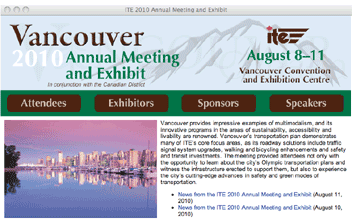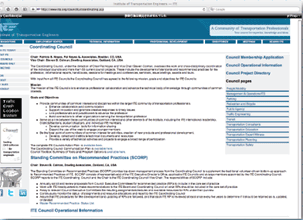Overseas News on Civil Engineering IT
|
|
This section focuses on a unique overseas website related to civil engineering IT. This issue features Institute of Transportation Engineers (ITE), an international educational and scientific association of transportation professionals who are responsible for meeting mobility and safety needs.
Based in Washington D.C., U.S.A, ITE is an active and interactive organization consisting of a large number of transportation professionals who are working for solving various issues related with transportation today. ITE moved its headquarter into the new office in the District in August 2010.
ITE promotes the application of technology and scientific principles to research, planning, functional design, implementation, operation, policy development and management for all modes of ground transportation. To put it concretely, through its products and services, ITE facilitates professional improvement of its members, assists education, encourages research, develops public awareness programs and serves as a mediator to exchange professional information. ITE was founded in 1930. This year, the Institute marked its 80th anniversary of its foundation.
In the meantime, ITE formed a community of a wide range of transportation professionals including transportation engineers, transportation planners, consultants, educators and researchers. Through meetings, seminars and publications, ITE has evolved into a network of more than 17,000 members, working in over 90 countries.
Based on such aspects, ITE positions itself as a source for expertise, knowledge and ideas.
The rapid development of motorization after the First World War resulted in problems such as traffic accidents and congestion in the early 20's. This caused public demands for expert attention to be paid to the mitigation of those problems. At the same time, some people began to recognize the value of engineering approaches in dealing with a lot of aspects of highway transportation problems.
At various national and regional conferences called for discussions of traffic problems, on the other hand, this ever-growing group of technicians got together, so by the late 20's engineers interested in highway traffic work were well acquainted.
This raised the desirability of forming a professional society, which was crystallized at a meeting in Pittsburgh in October, 1930. At this meeting, a small group of men who were making efforts to reduce accidents and facilitate traffic movement developed a tentative drafting of the Constitution and By-Laws for a professional traffic society. Its vision was conceived to serve as a central agency for correlating and disseminating the factual data and techniques developed by members of the profession, promoting the standards of traffic engineering and encouraging the establishment of traffic engineering departments in city and state governments whose techniques should make for safer and more efficient highway transportation.
Following this, at a meeting in New York in January 1931, Constitution and By-Laws were formally adopted and ITE started its substantial activities.
Some councils are established in ITE and its members are on the leading edge of issues through their participation in ITE's special interest councils.
The Coordinating Council oversees the work and cross-disciplinary coordination of the individual councils and their projects. The mission of the ITE Councils is so described as to enhance professional collaboration and advance the technical body of knowledge through communities of common interests. ITE further expresses its goals and objectives as follows:
- Provide communities of common interest and disciplines within the larger ITE community of transportation professionals.
- Serve as a link between these communities of common interest and other elements of the Institute, including the ITE international leadership, Districts/Sections, student chapters, and individual ITE members.
- Be the focal point of communities of common interest for activities, creation of new products and professional development.
Twelve councils are currently available for individual membership, including
- Freight Mobility
- Management & Operation/ITS
- Parking
- Pedestrian and Bicycle
- Public Agency
- Traffic Engineering
- Transit
- Transportation Consultants
- Transportation Education
- Transportation Expert Witness
- Transportation Planning
- Transportation Safety
ITE says that joining ITE will lead the members to advance their skill by using professional market opportunities that increase, ITE's industry resources, professional development, networking and leadership opportunities.
The top page of ITE Website shows corners of various items such as events and conferences that are coming soon, new publications, Web Seminars that are conducted as part of continuing education and training, as well as books and journals already issued.
(Written by Takashi IKENO, WritingSolutions Ltd.)
 |
 |
 |
||
¢Institute of Transportation Engineers (ITE)£ |
This article is written based on the above website with permission from ITE.(Images provided by ITE)
 |
||||
| BACK | LIST | NEXT |